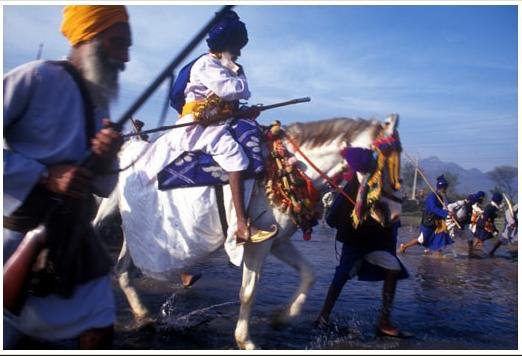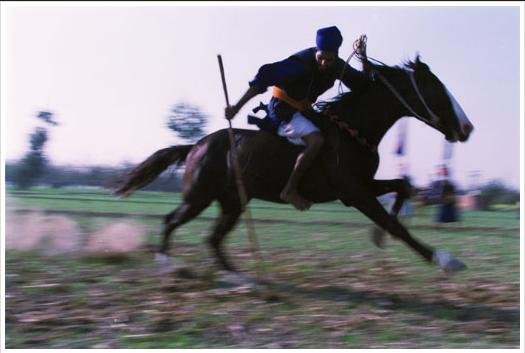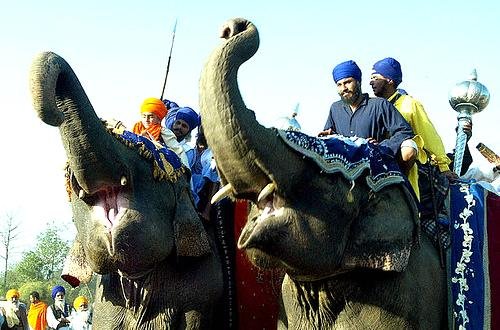 Hola Mohalla or Hola Mahalla or simply Hola is a Sikh festival that takes place on the first of the lunar month of Chet which usually falls in March. This, by a tradition estabished by Guru Gobind Singh, follows the Hindu festival of Holi by one day; Hola is the masculine form of the feminine sounding Holi. The word "Mohalla" is derived from the Arabic root hal (alighting, descending) and is a Punjabi word that implies an organized procession in the form of an army column. But unlike Holi, when people playfully sprinkle color, dry or mixed in water, on each other, the Guru made Hola Mohalla an occasion for the Sikhs to demonstrate their martial skills in simulated battles.
Hola Mohalla or Hola Mahalla or simply Hola is a Sikh festival that takes place on the first of the lunar month of Chet which usually falls in March. This, by a tradition estabished by Guru Gobind Singh, follows the Hindu festival of Holi by one day; Hola is the masculine form of the feminine sounding Holi. The word "Mohalla" is derived from the Arabic root hal (alighting, descending) and is a Punjabi word that implies an organized procession in the form of an army column. But unlike Holi, when people playfully sprinkle color, dry or mixed in water, on each other, the Guru made Hola Mohalla an occasion for the Sikhs to demonstrate their martial skills in simulated battles.
Together the words "Hola Mohalla" stands for "mock fight". During this festival, processions are organised in the form of army type columns accompanied by war-drums and standard-bearers and proceeding to a given spot or moving in state from one gurdwara to another. The custom originated in the time of Guru Gobind Singh who held the first such mock fight event at Anandpur in February 1701.
The foothills of the Shivaliks in Ropar district of Punjab's north-eastern region, especially around the historic townships of Anandpur Sahib and Kiratpur Sahib, have, since 1701 been playing host to Hola Mohalla. Recently, the Indian government accorded it the status of a national festival. The military exercise, which was personally supervised by the guru, was carried out on the bed of the River Charan Ganga with the famous Hindu temple of Mata Naina Devi in the Shivaliks as the backdrop.
This annual festival held at Anandpur Sahib in Punjab and now replicated at other Gurdwaras worldwide was started by the tenth Sikh Guru, as a gathering of Sikhs for military exercises and mock battles on the day following the festival of Holi at Anandpur Sahib. It reminds the people of valour and defence preparedness, concepts dear to the Tenth Guru who was at that time battling the Mughal empire and the hill kings.
 On this three-day grand festival, mock battles, exhibitions, display of weapons, etc., are held followed by kirtan, music and poetry competitions. The participants perform daring feats, such as Gatka (mock encounters with real weapons), tent pegging, bareback horse-riding, standing erect on two speeding horses and various other feats of bravery.
On this three-day grand festival, mock battles, exhibitions, display of weapons, etc., are held followed by kirtan, music and poetry competitions. The participants perform daring feats, such as Gatka (mock encounters with real weapons), tent pegging, bareback horse-riding, standing erect on two speeding horses and various other feats of bravery.
There are also a number of Darbars where the Sri Guru Granth Sahib is present and kirtan and religious lectures take place. On the last day a long procession, led by Panj Pyaras, starts from Takhat Keshgarh Sahib, one of the five Sikh religious seats, and passes through various important Gurdwaras like Qila Anandgarh, Lohgarh Sahib, Mata Jitoji and terminates at the Takhat (Keshgarh).
For people visiting Anandpur Sahib, langars (voluntary community kitchens) are organized by the local people as a part of sewa (community service). Raw materials like wheat flour, rice, vegetables, milk and sugar are provided by the villagers living nearby. Women volunteer to cook and others take part in cleaning utensils and other manual tasks that need to be carried out. Traditional cuisine is served to the pilgrims who eat while sitting in rows on the ground. (Pangat)
The Festival of Hola Mahalla
This custom originated in the time of Guru Gobind Singh (1666-1708) who held the first march at Anandpur on Chet vadi 1, 1757 Bk (22nd February, 1701). Unlike Holi, when people playfully sprinkle color, dry or mixed in water, on each other the Guru made Hola Mahalla an occasion for the Sikhs to demonstrate their martial skills in simulated battles. This was probably done forestalling a grimmer struggle against the imperial power following the battle of Ninnohgarh in 1700. Holla Mahalla became an annual event held in an open ground near Holgarh Fort across the rivulet Charan Ganga, northwest to the town of Anandpur sahib.
The popularity of this festival may be judged from the fact that out of five Sikh public holidays requested by the Khalsa Diwan, Lahore in 1889, the Government approved only two - Holla Mahalla and the birth anniversary of Guru Nanak. Hola Mahalla is presently the biggest festival at Anandpur. It will be appropriate here to discuss briefly the town and the participants of this festival.
Anandpur
Literally the City of Bliss, Anandpur is situated on one of the lower spurs of the Shiwalik Hills in Ropar District of Punjab and is well connected with the rest of the country both by road and rail. It lies 31 Kms north of Rupnagar (Ropar) and 29 Kms south of Nangal Township. Being one of the supremely important pilgrimage centers of the Sikhs it has been reverently called Anandpur Sahib. It will not be out of place here to mention that it was at Anandpur that on Baisakhi of 1699, Guru Gobind Singh carried out the supreme task of creating the Khalsa. It was here that the Guru announced the baptism of the Panj Piare and inaugurated the Khalsa, or the brotherhood of the holy soldiers who would henceforth be distinguished by five symbols all beginning with the letter "K" viz. kes (uncut hair), kangha (comb), kachcha (pair of shorts), kara (steel bracelet) and kirpan (sword). Sikhs were further instructed to live to the highest ethical standards, and to be always ready to fight tyranny and injustice.
Hola Mahalla festival
Having been the abode of the last two Sikh Gurus for two score years, the town was witness to many momentous events of Sikh history, including the Hola Mahalla festival, which is an annual feature. The festival has now lost much of its original military significance, but Sikhs in large numbers still assemble at Anandpur Sahib on this day and an impressive and colorful procession is taken out in which the Nihangs, in their traditional panoply, form the vanguard while parading their skill in the use of arms, horsemanship, tent-pegging, and other war-like sports.
Originally known as Akalis, the Nihngas or Nihang Singhs are endearingly designated as Guru's Knights or the Guru's beloved. They still carry the military ambience and heroic style that was cultivated during the lifetime of Guru Gobind Singh. Nihangs constitute a distinctive order among the Sikhs and are readily recognized by their dark blue loose apparel and their ample, peaked turbans festooned with quoits, insignia of the Khalsa and rosaries, all made of steel. They are always armed, and are usually seen mounted heavily laden with weapons such as swords, daggers, spears, rifles, shotguns, and pistols.
 The word Nihang can be traced back to Persian nihang (alligator, sword) or to Sanskrit nishanka (fearless, carefree). In the former sense, it seems to refer to the reckless courage members of this order displayed in battle. In Guru Gobind Singh's writing, Var Sri Bhagauti Ji 47, it is used for swordsmen warriors of the vanguard. Whatever may be the origin the word Nihang, it signifies the characteristic qualities of the clan- their freedom from fear of danger or death, readiness for action and non-attachment to worldly possessions. During the eighteenth century, one of the confederate armies of the Dal Khalsa, constituted of the Nishanvalia misl chief, Naina Singh, whose style of tightly tied tall turban with a dumala gained currency and those who adopted the style were called Akali Nihangs.
The word Nihang can be traced back to Persian nihang (alligator, sword) or to Sanskrit nishanka (fearless, carefree). In the former sense, it seems to refer to the reckless courage members of this order displayed in battle. In Guru Gobind Singh's writing, Var Sri Bhagauti Ji 47, it is used for swordsmen warriors of the vanguard. Whatever may be the origin the word Nihang, it signifies the characteristic qualities of the clan- their freedom from fear of danger or death, readiness for action and non-attachment to worldly possessions. During the eighteenth century, one of the confederate armies of the Dal Khalsa, constituted of the Nishanvalia misl chief, Naina Singh, whose style of tightly tied tall turban with a dumala gained currency and those who adopted the style were called Akali Nihangs.
The self-discipline and privilege they gained of convening at Akal Takht general assemblies of the Khalsa, brought the Nihangs into importance far out of proportion to their numbers or political authority. In the time of Maharaja Ranjit Singh (1780-1839), the Akali Nihangs maintained their independent existence. Their leader Phoola Singh Nihang, then custodian of the Akal Takht, was the voice of the religious and the moral conscience of the State, and at times he even censured and chastised the sovereign himself.
The Nihangs are today divided into several groups, each with its own Chaoni (cantonment), but they are loosely organized into two Dals (forces) - Buddha Dal and the Taruna Dal. These names were initially given to the two sections into which the Khalsa army was divided in 1733. Buddha Dal has its Chaoni at Talvandi Sabo in Bhatinda District, while the main Chaoni of the Taruna Dal Nihangs is at Baba Bakala. in Amritsar District.
The week long festival of Hola Mahalla concludes at Gurdwara Holgarh Sahib (which stands on the site of Holgarh Fort), one and half Km northwest of town across the Charan Ganga rivulet. It was here that Guru Gobind Singh introduced in the spring of 1701 the celebration of Holla on the day following the Hindu festival of Holi . Unlike the playful sprinkling of colors as is done during Holi, the Guru made Holla an occasion to demonstrate skills in simulated battle, which is presently carried out by the Nihangs.
The Nihangs assemble in thousands at Anandpur Sahib in March every year to celebrate Hola Mahalla. On this occasion they hold tournaments of military skills, including mock battles. The most spectacular event at the Hola Mahalla is the magnificent procession of Nihangs on horses and elephants and on foot carrying a variety of traditional and modern weapons and demonstrating their skill in using them. The Hola Mahalla festival is unique and distinguishable from other festivals in that the Nihang have tried to preserve the traditional form and content as established during its inception, and strictly observed by the Akalis for more than three centuries.
Upper two photos courtesy of Nick Fleming
Bottom photo courtesy of Daljeet Singh

